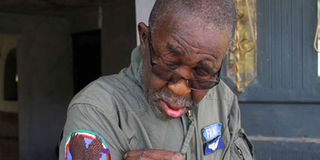Captain Frank Njoroge dreamed of ending oppression only to end up in mire

Captain Frank Njoroge displays an insignia during an interview at his home in Syokimau, Machakos County, on March 28, 2018. PHOTO | DENNIS ONSONGO | NATION MEDIA GROUP
What you need to know:
- Frank first trained as a soldier at the Lanet barracks before moving to Gilgil for paramilitary training.
- One of the high points in his life was the day he became one of 26 pilots to graduate from the Kenya Air Force Training School.
Growing up in Nakuru in the 1960s, Captain Frank Njoroge’s boyhood ambition was to become a jet fighter pilot; and he had a pretty good idea where he wanted to go for combat — South Africa.
“I had read many books about apartheid,” says the lanky man who spots a greying stable of a beard and who shields his sunken eyes behind dark glasses.
Learning about the injustices that apartheid subjected Africans to, Frank had only one desire as a boy: To drop bombs all over South Africa in the hope that this would liberate his fellow Africans from the yoke of oppression.
KENYA AIR FORCE
Dreams do come true, but not always in the way that one expects.
When Frank left Menengai High School, he joined the Air Force as a cadet pilot, first training as a soldier at the Lanet barracks in 1977 before moving to Gilgil for paramilitary training after which he enrolled with the Kenya Air Force Training School.
“I have never known anything else except flying,” he says of his life as he reflected on the high and low moments that have shaped his career over the years.
One of the high points in his life was the day he became one of 26 pilots to graduate from the Kenya Air Force Training School.
JET FIGHTERS
About 100 cadets had been selected but only the 26 successfully completed the training.
Of these, 23 were sent to India for basic flight training... and Frank was not among them.
For a moment, he thought that he and his two colleagues would be dropped from the military.
Little did he know that they had been specifically hand-picked to fly jet fighters also known as the F5s — the jets that do all manner of manoeuvres, including what Frank calls ‘the Cuban 8’ — during national holidays.
To this day, the exhilaration of executing the manoeuvres still excites him and he becomes animated just talking about it.
TRAINING
Together with his two colleagues, Frank was sent for further training at the Sheppard Air Force Base in Texas, US, to train as jet fighter pilots, graduating in April 1979.
“I was the first in my class to fly F5 aerobatics and the second to fly solo,” Frank says before he rises from his seat to reach for his green flying overalls, which have grown slightly shorter at the ankles as the years have rolled on.
He is proud of the insignia on the right shoulder and the white wings above the left breast.
Only those who were in the same class with him have it.
“No one can take this away from me,” he says, shaking with pride, his fingers running over the symbols of his training.
WAR ZONE
The eczema that has been raving his skin is evident in his fingers and flaking wrists as he traces his fingers over the military symbols that give him pride.
Time and illness have not been kind to the captain’s hands, but they have piloted planes to countless places and he has a record that speaks for itself, including being shot at 18 times once as he flew over Kismayu in Somalia.
“I have been flying since 1978,” he says. However, the events that started when his small plane crashed in South Sudan on January 7 remain the darkest part of his long career.
“I wish I could get over it,” he says, tears welling up in his eyes as he gazes at the skies forlornly, lost in thought, before emotions get the better of him and he walks away, wiping the tears streaming freely down his cheeks.





